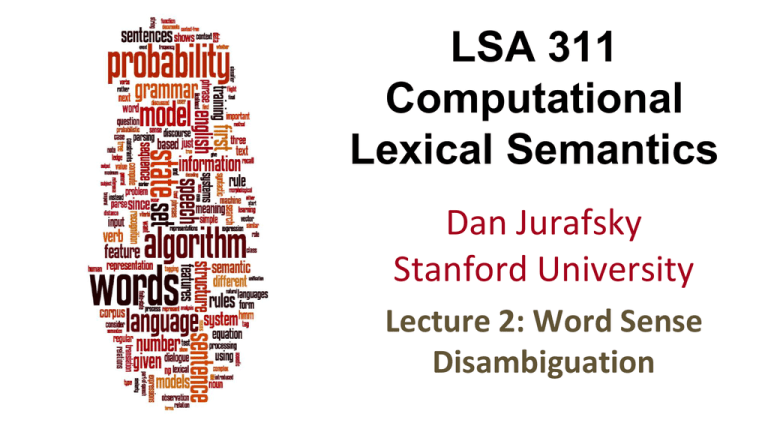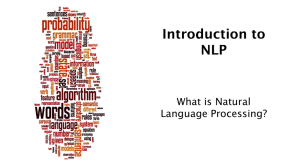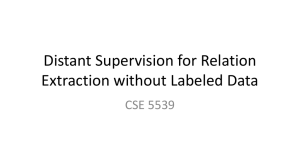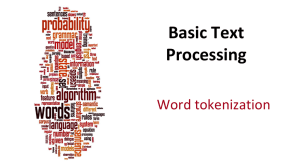pptx - Stanford University
advertisement

LSA 311
Computational
Lexical Semantics
Dan Jurafsky
Stanford University
Lecture 2: Word Sense
Disambiguation
Dan Jurafsky
Word Sense Disambiguation (WSD)
• Given
• A word in context
• A fixed inventory of potential word senses
• Decide which sense of the word this is
• Why? Machine translation, QA, speech synthesis
• What set of senses?
• English-to-Spanish MT: set of Spanish translations
• Speech Synthesis: homographs like bass and bow
• In general: the senses in a thesaurus like WordNet
Dan Jurafsky
Two variants of WSD task
• Lexical Sample task
• Small pre-selected set of target words (line, plant)
• And inventory of senses for each word
• Supervised machine learning: train a classifier for each word
• All-words task
• Every word in an entire text
• A lexicon with senses for each word
• Data sparseness: can’t train word-specific classifiers
Dan Jurafsky
WSD Methods
• Supervised Machine Learning
• Thesaurus/Dictionary Methods
• Semi-Supervised Learning
4
Word Sense
Disambiguation
Supervised
Machine Learning
Dan Jurafsky
Supervised Machine Learning Approaches
• Supervised machine learning approach:
• a training corpus of words tagged in context with their sense
• used to train a classifier that can tag words in new text
• Summary of what we need:
•
•
•
•
the tag set (“sense inventory”)
the training corpus
A set of features extracted from the training corpus
A classifier
Dan Jurafsky
Supervised WSD 1: WSD Tags
• What’s a tag?
A dictionary sense?
• For example, for WordNet an instance of “bass” in a text has 8
possible tags or labels (bass1 through bass8).
Dan Jurafsky
8 senses of “bass” in WordNet
1.
2.
3.
4.
5.
6.
7.
8.
bass - (the lowest part of the musical range)
bass, bass part - (the lowest part in polyphonic music)
bass, basso - (an adult male singer with the lowest voice)
sea bass, bass - (flesh of lean-fleshed saltwater fish of the family
Serranidae)
freshwater bass, bass - (any of various North American lean-fleshed
freshwater fishes especially of the genus Micropterus)
bass, bass voice, basso - (the lowest adult male singing voice)
bass - (the member with the lowest range of a family of musical
instruments)
bass - (nontechnical name for any of numerous edible marine and
freshwater spiny-finned fishes)
Dan Jurafsky
Inventory of sense tags for bass
Dan Jurafsky
Supervised WSD 2: Get a corpus
• Lexical sample task:
• Line-hard-serve corpus - 4000 examples of each
• Interest corpus - 2369 sense-tagged examples
• All words:
• Semantic concordance: a corpus in which each open-class word is labeled
with a sense from a specific dictionary/thesaurus.
• SemCor: 234,000 words from Brown Corpus, manually tagged with
WordNet senses
• SENSEVAL-3 competition corpora - 2081 tagged word tokens
Dan Jurafsky
SemCor
<wf pos=PRP>He</wf>
<wf pos=VB lemma=recognize wnsn=4 lexsn=2:31:00::>recognized</wf>
<wf pos=DT>the</wf>
<wf pos=NN lemma=gesture wnsn=1 lexsn=1:04:00::>gesture</wf>
<punc>.</punc>
11
Dan Jurafsky
Supervised WSD 3: Extract feature vectors
Intuition from Warren Weaver (1955):
“If one examines the words in a book, one at a time as through
an opaque mask with a hole in it one word wide, then it is
obviously impossible to determine, one at a time, the meaning
of the words…
But if one lengthens the slit in the opaque mask, until one can
see not only the central word in question but also say N words
on either side, then if N is large enough one can unambiguously
decide the meaning of the central word…
The practical question is : ``What minimum value of N will, at
least in a tolerable fraction of cases, lead to the correct choice
of meaning for the central word?”
Dan Jurafsky
Feature vectors
• A simple representation for each observation
(each instance of a target word)
• Vectors of sets of feature/value pairs
• Represented as a ordered list of values
• These vectors represent, e.g., the window of words around
the target
Dan Jurafsky
Two kinds of features in the vectors
• Collocational features and bag-of-words features
• Collocational
• Features about words at specific positions near target word
• Often limited to just word identity and POS
• Bag-of-words
• Features about words that occur anywhere in the window (regardless
of position)
• Typically limited to frequency counts
Dan Jurafsky
Examples
• Example text (WSJ):
An electric guitar and bass player stand off to
one side not really part of the scene
• Assume a window of +/- 2 from the target
Dan Jurafsky
Examples
• Example text (WSJ)
An electric guitar and bass player stand off to
one side not really part of the scene,
• Assume a window of +/- 2 from the target
Dan Jurafsky
Collocational features
• Position-specific information about the words and
collocations in window
• guitar and bass player stand
• word 1,2,3 grams in window of ±3 is common
Dan Jurafsky
Bag-of-words features
•
•
•
•
“an unordered set of words” – position ignored
Counts of words occur within the window.
First choose a vocabulary
Then count how often each of those terms occurs in a
given window
• sometimes just a binary “indicator” 1 or 0
Dan Jurafsky
Co-Occurrence Example
• Assume we’ve settled on a possible vocabulary of 12 words in
“bass” sentences:
[fishing, big, sound, player, fly, rod, pound, double, runs, playing, guitar, band]
• The vector for:
guitar and bass player stand
[0,0,0,1,0,0,0,0,0,0,1,0]
Word Sense
Disambiguation
Classification
Dan Jurafsky
Classification: definition
• Input:
• a word w and some features f
• a fixed set of classes C = {c1, c2,…, cJ}
• Output: a predicted class c∈C
Dan Jurafsky
Classification Methods:
Supervised Machine Learning
• Input:
• a word w in a text window d (which we’ll call a “document”)
• a fixed set of classes C = {c1, c2,…, cJ}
• A training set of m hand-labeled text windows again called
“documents” (d1,c1),....,(dm,cm)
• Output:
• a learned classifier γ:d c
22
Classification Methods:
Supervised Machine Learning
Dan Jurafsky
• Any kind of classifier
•
•
•
•
•
Naive Bayes
Logistic regression
Neural Networks
Support-vector machines
k-Nearest Neighbors
• …
Word Sense
Disambiguation
The Naive Bayes
Classifier
Dan Jurafsky
Naive Bayes Intuition
• Simple (“naive”) classification method based on
Bayes rule
• Relies on very simple representation of document
• Bag of words
Dan Jurafsky
I’ll introduce classification with an even
simpler supervised learning task
Let’s classify a movie review as positive (+) or negative (-)
Suppose we have lots of reviews labeled as (+) or (-) and I give you
a new review.
Given: the words in this new movie review
Return: one of 2 classes: + or –
26
Dan Jurafsky
The Bag of Words Representation
27
Dan Jurafsky
The bag of words representation
γ(
seen
sweet
2
1
whimsical
1
recommend
happy
1
1
...
...
)=c
Dan Jurafsky
Bayes’ Rule Applied to Documents and
Classes
•For a document d and a class c
P(d | c)P(c)
P(c | d) =
P(d)
Dan Jurafsky
Naive Bayes Classifier (I)
cMAP = argmax P(c | d)
cÎC
MAP is “maximum a
posteriori” = most
likely class
P(d | c)P(c)
= argmax
cÎC
P(d)
= argmax P(d | c)P(c)
cÎC
Bayes Rule
Dropping the
denominator
Dan Jurafsky
Naive Bayes Classifier (II)
cMAP = argmax P(d | c)P(c)
cÎC
= argmax P(x1, x2,… , xn | c)P(c)
cÎC
Document d
represented as
features
x1..xn
Dan Jurafsky
Naive Bayes Classifier (IV)
cMAP = argmax P(x1, x2,… , xn | c)P(c)
cÎC
O(|X|n•|C|) parameters
Could only be estimated if a
very, very large number of
training examples was
available.
How often does this
class occur?
We can just count the
relative frequencies in
a corpus
Dan Jurafsky
Multinomial Naive Bayes Independence
Assumptions
P(x1, x2,… , xn | c)
• Bag of Words assumption: Assume position doesn’t
matter
• Conditional Independence: Assume the feature
probabilities P(xi|cj) are independent given the class c.
P(x1,… , xn | c) = P(x1 | c)·P(x2 | c)·P(x3 | c)·...·P(xn | c)
Dan Jurafsky
Multinomial Naive Bayes Classifier
cMAP = argmax P(x1, x2,… , xn | c)P(c)
cÎC
cNB = argmax P(c j )Õ P(x | c)
cÎC
xÎX
Dan Jurafsky
Applying Multinomial Naive Bayes
Classifiers to Text Classification
positions = all word positions in test document
cNB = argmax P(c j )
c j ÎC
Õ
iÎ positions
P(xi | c j )
Classification
Naive Bayes
Classification
Learning the Naive
Bayes Classifier
Sec.13.3
Dan Jurafsky
Learning the Multinomial Naive Bayes Model
• First attempt: maximum likelihood estimates
• simply use the frequencies in the data
P̂(c j ) =
P̂(wi | c j ) =
doccount(C = c j )
N doc
count(wi , c j )
å count(w, c j )
wÎV
Dan Jurafsky
Parameter estimation
P̂(wi | c j ) =
count(wi , c j )
å count(w, c j )
fraction of times word wi appears
among all words in documents of topic cj
wÎV
• Create mega-document for topic j by concatenating all docs in
this topic
• Use frequency of w in mega-document
Sec.13.3
Dan Jurafsky
Problem with Maximum Likelihood
• What if we have seen no training documents with the word
fantastic and classified in the topic positive (thumbs-up)?
P̂("fantastic" positive) =
count("fantastic", positive)
= 0
å count(w, positive)
wÎV
• Zero probabilities cannot be conditioned away, no matter
the other evidence!
cMAP = argmaxc P̂(c)Õ P̂(xi | c)
i
Dan Jurafsky
Laplace (add-1) smoothing for Naïve Bayes
count(wi , c) +1
P̂(wi | c) =
å (count(w, c))+1)
wÎV
count(wi , c) +1
=
æ
ö
çç å count(w, c)÷÷ + V
è wÎV
ø
Dan Jurafsky
Multinomial Naïve Bayes: Learning
• From training corpus, extract Vocabulary
• Calculate P(cj) terms
• Calculate P(wk | cj) terms
• For each cj in C do
docsj all docs with class =cj
P(c j ) ¬
| docs j |
| total # documents|
• Textj single doc containing all docsj
• For each word wk in Vocabulary
nk # of occurrences of wk in Textj
P(wk | c j ) ¬
nk + a
n + a | Vocabulary |
Word Sense
Disambiguation
Learning the Naive
Bayes Classifier
Word Sense
Disambiguation
Multinomial Naive
Bayes: A Worked
Example for WSD
Dan Jurafsky
Applying Naive Bayes to WSD
• P(c) is the prior probability of that sense
• Counting in a labeled training set.
• P(w|c) conditional probability of a word given a particular sense
• P(w|c) = count(w,c)/count(c)
• We get both of these from a tagged corpus like SemCor
• Can also generalize to look at other features besides words.
• Then it would be P(f|c)
• Conditional probability of a feature given a sense
Dan Jurafsky
P̂(c) =
P̂(w | c) =
Nc
N
count(w, c) +1
count(c)+ | V |
Priors:
P(f)= 3
4 1
P(g)=
4
Training
Test
Doc
1
2
3
4
5
Words
fish smoked fish
fish line
fish haul smoked
guitar jazz line
line guitar jazz jazz
Class
f
f
f
g
?
V = {fish, smoked, line, haul, guitar, jazz}
Choosing a class:
P(f|d5) 3/4 * 2/14 * (1/14)2 * 1/14
≈ 0.00003
46
Conditional Probabilities:
(1+1) / (8+6) = 2/14
P(line|f) =
P(guitar|f) = (0+1) / (8+6) = 1/14
P(jazz|f) =
(0+1) / (8+6) = 1/14
P(line|g) =
(1+1) / (3+6) = 2/9
P(guitar|g) = (1+1) / (3+6) = 2/9
(1+1) / (3+6) = 2/9
P(jazz|g) =
P(g|d5) 1/4 * 2/9 * (2/9)2 * 2/9
≈ 0.0006
Word Sense
Disambiguation
Evaluations and
Baselines
Dan Jurafsky
WSD Evaluations and baselines
• Best evaluation: extrinsic (‘end-to-end’, `task-based’) evaluation
• Embed WSD algorithm in a task and see if you can do the task better!
• What we often do for convenience: intrinsic evaluation
• Exact match sense accuracy
• % of words tagged identically with the human-manual sense tags
• Usually evaluate using held-out data from same labeled corpus
• Baselines
• Most frequent sense
• The Lesk algorithm
Dan Jurafsky
Most Frequent Sense
• WordNet senses are ordered in frequency order
• So “most frequent sense” in WordNet = “take the first sense”
• Sense frequencies come from the SemCor corpus
Dan Jurafsky
Ceiling
• Human inter-annotator agreement
• Compare annotations of two humans
• On same data
• Given same tagging guidelines
• Human agreements on all-words corpora with
WordNet style senses
• 75%-80%
Word Sense
Disambiguation
Dictionary and
Thesaurus Methods
Dan Jurafsky
The Simplified Lesk algorithm
• Let’s disambiguate “bank” in this sentence:
The bank can guarantee deposits will eventually cover future tuition costs
because it invests in adjustable-rate mortgage securities.
• given the following two WordNet senses:
Dan Jurafsky
The Simplified Lesk algorithm
Choose sense with most word overlap between gloss and context
(not counting function words)
The bank can guarantee deposits will eventually cover future
tuition costs because it invests in adjustable-rate mortgage
securities.
Dan Jurafsky
The Corpus Lesk algorithm
• Assumes we have some sense-labeled data (like SemCor)
• Take all the sentences with the relevant word sense:
These short, "streamlined" meetings usually are sponsored by local banks1,
Chambers of Commerce, trade associations, or other civic organizations.
• Now add these to the gloss + examples for each sense, call it the
“signature” of a sense.
• Choose sense with most word overlap between context and
signature.
Dan Jurafsky
Corpus Lesk: IDF weighting
• Instead of just removing function words
• Weigh each word by its `promiscuity’ across documents
• Down-weights words that occur in every `document’ (gloss, example, etc)
• These are generally function words, but is a more fine-grained measure
• Weigh each overlapping word by inverse document frequency
55
Dan Jurafsky
Corpus Lesk: IDF weighting
• Weigh each overlapping word by inverse document frequency
• N is the total number of documents
• dfi = “document frequency of word i”
• = # of documents with word I
score(sense , context ) =
j
i
56
æ ö
N÷
ç
idfi = log
ç df ÷
è iø
å
w Î overlap(signature , context )
i
j
idf
w
Dan Jurafsky
Graph-based methods
• First, WordNet can be viewed as a graph
• senses are nodes
• relations (hypernymy, meronymy) are edges
• Also add edge between word and unambiguous gloss words
57
Dan Jurafsky
How to use the graph for WSD
• Insert target word and words in its sentential context into the
graph, with directed edges to their senses
“She drank some milk”
• Now choose the
most central sense
Add some probability to
“drink” and “milk” and
compute node with
highest
“pagerank”
58
Word Sense
Disambiguation
Semi-Supervised
Learning
Dan Jurafsky
Semi-Supervised Learning
Problem: supervised and dictionary-based
approaches require large hand-built resources
What if you don’t have so much training data?
Solution: Bootstrapping
Generalize from a very small hand-labeled seed-set.
Dan Jurafsky
Bootstrapping
• For bass
• Rely on “One sense per collocation” rule
• A word reoccurring in collocation with the same word will almost
surely have the same sense.
• the word play occurs with the music sense of bass
• the word fish occurs with the fish sense of bass
Dan Jurafsky
Sentences extracting using “fish” and
“play”
Dan Jurafsky
Summary: generating seeds
1) Hand labeling
2) “One sense per collocation”:
•
A word reoccurring in collocation with the same word will almost surely
have the same sense.
3) “One sense per discourse”:
•
•
The sense of a word is highly consistent within a document - Yarowsky
(1995)
(At least for non-function words, and especially topic-specific words)
Dan Jurafsky
Stages in the Yarowsky bootstrapping
algorithm for the word “plant”
Dan Jurafsky
Summary
• Word Sense Disambiguation: choosing correct sense in context
• Applications: MT, QA, etc.
• Three classes of Methods
• Supervised Machine Learning: Naive Bayes classifier
• Thesaurus/Dictionary Methods
• Semi-Supervised Learning
• Main intuition
65
• There is lots of information in a word’s context
• Simple algorithms based just on word counts can be surprisingly good







